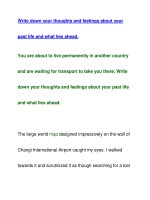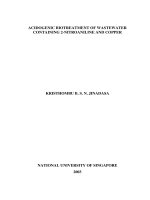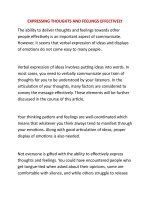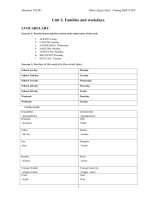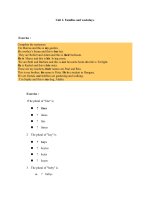2 thoughts and notions
Bạn đang xem bản rút gọn của tài liệu. Xem và tải ngay bản đầy đủ của tài liệu tại đây (9.26 MB, 209 trang )
Thoughts and Notions
HIGH BEGINNER READING PRACTICE
ismail - [2010]
Thoughts and Notions
Unit 1
Inventions and Inventors
……………………………………………………………………………………………………………………………………………………
Context Clues
5
1.
2.
3.
4.
5.
The Zipper
The Postage Stamp
Pencils and Pens
Umbrellas
The Metric System
Word Study
Extension Activities
- CNN Video Activity: Stampmakers
- Activity Page
- Dictionary Page
7
13
18
24
29
34
38
41
42
Unit 2
Unusual Sports
……………………………………………………………………………………………………………………………………………………..
Context Clues
44
1. Thai Boxing
46
2. Curling
52
3. Lacrosse
57
4. Sumo
62
5. Tarahumara Foot Races
67
Word Study
72
Extension Activities
- CNN Video Activity: Japan/Sumo
75
- Activity Page
78
- Dictionary Page
79
Unit 3
Food
……………………………………………………………………………………………………………………………………………………..
Context Clues
82
1. The Puffer Fish
84
2. Foods from Around the World
89
3. Chocolate
94
4. The Healthy Hunza
99
5. Food of the Future?
105
Word Study
110
1
Thoughts and Notions
Extension Activities
- CNN Video Activity: Fugu
- Activity Page
- Dictionary Page
113
116
119
Unit 4
Mysteries
……………………………………………………………………………………………………………………………………………………..
Context Clues
122
1. The Marie Celeste
124
2. The Poltergeist of Rosenheim
130
3. The Roanoke Settlement
135
4. The Easter Island Statues
141
5. The Tunguska Fireball
146
Word Study
151
Extension Activities
- CNN Video Activity: Easter Island Statues
155
- Activity Page
158
- Dictionary Page
160
Unit 5
Business
……………………………………………………………………………………………………………………………………………………
Context Clues
163
1. The History of Money
166
2. Mass Marketing: The Coca-Cola Story
173
3. The Bar Code
180
4. Inflation
186
5. Doing Business Around the World
192
Word Study
198
Extension Activities
- CNN Video Activity: Ads
202
- Activity Page
205
- Dictionary Page
206
2
Thoughts and Notions
Unit 1
Inventions and
Inventors
3
Thoughts and Notions
Context Clues
Put a circle around the letter of the best answer.
1. Tony and Ann got married three years ago. Then they started fighting a lot. Now the
couples are living apart. They live in different apartments.
a. above
c. not together
b. among
d. agree
2. Ali put a strip of paper in his book so he could remember what page he was.
a. heavy piece
c. long thin piece
b. dark piece
d. dirty piece
3. There is a row of trees along each side of our street.
a. line
c. jungle
b. forest
d. beard
4. Half a dozen eggs is six eggs.
a. fourteen
b. twelve
c. eight
d. sixteen
5. Paper is flexible. Wood and stone are not flexible.
a. You can pick it up.
c. You can move it back and forth.
b. You can carry it.
d. You can hit it.
6. The paper carrier delivers a newspaper to my apartment every morning. I don’t have to
go out and buy one.
a. hurries
c. defeats
d. buys
b. brings
7. I tried to pay the government worker for helping me. She didn’t accept the money. The
government pays her and she didn’t want my money.
a. bring
c. take
b. shoot
d. suppose
8. Sam received a package from his parents yesterday. It was a birthday present.
a. brought
c. spent
b. got
d. told
9. Stop talking immediately! The test started five minutes ago.
a. soon
c. daily
b. possibly
d. right now
4
Thoughts and Notions
10. Mr. Brown is a pilot for British Airways. He flies airplane all over the world.
a. businessman
c. driver of an airplane
b. carpenter
d. writer for a newspaper
11. There are no classes this afternoon. You have no homework. You can do whatever you
like.
a. anything
c. anytime
b. anywhere
d. anyone
12. Saudi Arabia has a desert climate. Canada has a cold climate in winter. The climate in
Indonesia is tropical.
a. The way the weather is all the time.
b. The changes in the weather every day.
c. Hot and Dry
d. Snow and Ice
5
Thoughts and Notions
LESSON
1
THE ZIPPER
PRE-READING QUESTIONS
……………………………………….
1. Are you wearing a zipper?
2. What do you do when you break your zipper?
3. Do you have clothing without zippers? How does it close?
6
Thoughts and Notions
1
The Zipper
The zipper is a wonderful invention. How did people ever live without zippers? They are
very common, so we forgot that they are wonderful. They are very strong, but they open and
close very easily. They come in many colors and sizes.
In the 1890s, people in the United States wore high shoes with long row of buttons.
Women’s clothes often had rows of buttons too. People wanted an easier way to put on and
take off clothes.
Whitcomb L. Judson invented the zipper in 1893. He was an engineer in Chicago. He
called the zipper a slide fastener. However, it didn’t stay closed very well. This was
embarrassing, and people didn’t buy many of them. Then Dr. Gideon Sundback from Sweden
solved this problem.
A zipper has three parts: 1. there are dozens of metal or plastic hooks (called teeth) on
two rows. 2. These are fastened to two strips of cloth. The cloth strips are flexible. They bend
easily. 3. A fastener slides the other way, it takes the hooks apart.
Dr. Sundback put the hooks on the strips of cloth. The cloth holds all the hooks in place.
They don’t come apart very easily. This solved the problem of the zippers.
row – line
dozens – a dozen = 12
7
Thoughts and Notions
A. Vocabulary
Put the right word in the blanks. The sentences are from the text.
zipper
sizes
bend
embarrassing
fastener
apart
hooks
flexible
strips
dozens
slide
row
1. In the 1890s, people in the United States wore high shoes with long
______________ of buttons.
2. There are ______________of metal or plastic ______________ (called teeth) in two
rows.
3. The ______________ is a wonderful invention.
4. The cloth strips are ______________.
5. He called the zipper a ______________.
6. When it slides the other way, it takes the hooks ______________.
7. This was ______________ and people didn’t buy many of them.
8. They ______________ easily.
9. These are fastened to two ______________ cloth.
B. Vocabulary (new context)
Put the right word in the blanks.
embarrassed
hooks
apart
strips
rows
dozen
flexible
fasteners
slide
zippers
bend
size
1. Icy roads are dangerous because cars ______________ on them.
2. Pam cut a piece of paper into ______________.
3. Sometimes your face gets red when you feel ______________.
4. A pencil is not ______________. Paper is.
5. Hooks, buttons, and zippers are all ______________.
6. American supermarkets sell eggs by the ______________.
7. Tony and George had an apartment together, but now they live ______________.
8. Students sit in a circle in some classes. They sit in ______________ in others.
9. People catch fish with ______________.
10. You ______________ your knees when you sit down.
11. Most pants and jackets have ______________.
8
Thoughts and Notions
C. Vocabulary Review
Put the right word in the blanks.
leaves
map
canoe
navy
axe
shells
current
jungle
froze
might
over
independent
spirits
history
death
shoot
1.
2.
3.
4.
5.
6.
7.
8.
Mary’s father was in the ______________ for twenty years.
Did you ever cut wood with an ______________?
What time does the meeting begin, and when will it be ______________?
Carl put water in the freezer part of the refrigerator. It ______________.
Giraffes live in grasslands. Some tigers live in the ______________.
Carlos had to go back to his country because of a ______________ in his family.
Most trees have hundreds of ______________.
The Labrador ______________ brings cold water from eastern Canada to the east
coast of the United States.
9. Students usually have to memorize dates when they study ______________.
10. Ann and Paula took a long ______________ trip on a quiet river during their
vacation.
11. Tom is very ______________. He likes to think and do things for himself.
12. Soldiers have to learn to ______________ guns.
D. Comprehension
Put a circle around the letter of the best answer.
1. Zippers open and close by ______________.
a. Shooting
b. Sliding
c. Bending
d. Choosing
2. The hooks are ______________.
a. Plastic
b. Metal
c. Cloth
d. A and B
9
Thoughts and Notions
3. Mr. Judson didn’t sell many zippers because ______________.
a. It was hard to open and close them
b. People liked rows of buttons
c. They had cloth strips
d. They came open very easily
4. Mr. Judson was an ______________.
a. engineer
b. inventor
c. American
d. A, B, and C
5. Dr. Sundback was ______________.
a. a Swede
b. from Chicago
c. an American
d. B and C
6. A zipper has two ______________ of cloth.
a. rows
b. fasteners
c. strips
d. buttons
7. ______________ are flexible.
a. The hooks
b. The rows of buttons
c. The fasteners
d. The strips of cloth
8. Dr. Sundback ______________.
a. invented the zipper
b. made the zipper better
c. invented the button hook
d. invented the slide fastener
10
Thoughts and Notions
E. Questions
The asterisk (*) means you have to think of the answer. You cannot find it in the text.
1. Why do we forget that zippers are wonderful?
2. Are zippers strong?
3. What kind of shoes did Americans wear in the 1890s?
4. Who invented the zipper? When did he invent it?
5. Why is slide fastener a good name for a zipper?*
6. Why were the first zippers embarrassing?
7. What country was Dr. Sundback from?
8. Describe a zipper. How does it work?
9. What part of the zipper is flexible?
10. What did Dr. Sundback do to make zippers better?
11. What is a newer kind of fastener than the zipper?*
F. Main Idea
Which is the main idea of this chapter? Choose one.
1. A zipper has hooks, cloth strips, and a slide fastener.
2. People didn’t like the first zippers.
3. Mr. Judson and Dr. Sundback gave us a wonderful invention, the zipper.
11
Thoughts and Notions
LESSON
2
THE POSTAGE STAMP
PRE-READING QUESTIONS
………………………………………..
1. Does someone in the class have a postage stamp? What does it look like?
2. Do you write letters to your relatives?
Do you call them on the telephone?
Which is more expensive?
3. Name a famous person on a postage stamp.
12
Thoughts and Notions
2
The Postage Stamp
Before the invention of the postage stamp, it was difficult to send a letter to another
country. The sender paid for the letter to travel in his or her own country. Then the person in
the other country paid for that part of the trip. If a letter crossed several countries, the problem
was worse.
Rowland Hill, a British teacher, had the idea of a postage stamp with glue on the back.
The British post office made the first stamps in 1840. They were the penny black and the
Twopence Blue. A person bought a stamp and put in on a letter. The post office delivered the
letter. When people received letters, they didn’t have to pay anything. The letters were
prepaid.
Postage stamps became popular in Great Britain immediately. Other countries started
making their own postage stamps very quickly.
There were still problems with international mail. Some countries did not want to
accept any letters with stamps from another country. Finally, in 1874, a German organized the
Universal Postal System. Each country in the UPS agreed to accept letters with prepaid postage
from the other members. Today, the offices of the UPS are in Switzerland. Almost every
country in the world is a member of this organization. It takes care of any international mail
problems.
Today, post offices in every country sell beautiful stamps. Collecting stamps is one of the
popular hobbies in the world, and every stamp collector knows about the Penny Black and the
Twopence Blue.
crossed – went across
delivered – took it to the person
received – got
prepaid – paid for before
immediately – right away, right now
accept - take
13
Thoughts and Notions
A. Vocabulary
Put the right word in the blanks. The sentences are from the text.
crossed
prepaid
stamp
received
members
delivered
postage
glue
international mail
immediately accept
1. When people ______________ letters they didn’t have to pay anything.
2. Before the invention of the ______________ ______________,it was difficult to
send a letter to another country.
3. The post office ______________ the letter.
4. Each country in the UPS agreed to accept letters with prepaid postage from the
other ______________.
5. If a letter ______________ several countries, the problem was worse.
6. Postage stamps became popular in Great Britain ______________.
7. Some countries did not want to ______________ letters with stamps from other
countries.
8. The letters were ______________.
9. There were still problems with international ______________.
10. Rowland Hill, a British teacher, had the idea of a postage stamp with
______________ on the back.
B. Vocabulary ( new context)
Put the right word in the blanks.
prepay
deliver
accept
cross
worse
stamps
postage
glue
members
immediately
receive
1. Jamal and Marie are ______________ of the International Students Club.
2. When you rent an apartment for year, you have to ______________ the last
month’s rent. You pay the first and the last month’s rent.
3. Children have to be careful when they ______________ the street.
4. Mr. Ross is going to the post office because he has to buy some ______________.
5. If you buy living room furniture, the store will ______________ it.
6. How much is the ______________ for an airmail letter to Japan?
7. Did you ______________ any letters this week?
8. Please go to your office ______________. You have a phone call.
9. The teacher will not ______________ homework if it is a week late. She won’t take it.
10. Did you get any ______________ today?
11. ______________ helps a stamp stay on a letter.
14
Thoughts and Notions
C. Vocabulary Review: Opposites
Match the words that mean the opposite.
Column A
1. apart ______________
2. bought ______________
3. found ______________
4. arrived ______________
5. bottom ______________
6. know ______________
7. glad ______________
8. unusual ______________
9. able ______________
10. birth ______________
11. saved ______________
12. at first ______________
13. brave ______________
14. left ______________
Column B
a. top
b. left
c. suppose
d. spent
e. took
f. unable
g. gold
h. choose
i. finally
j. afraid
k. together
l. death
m. ordinary
n. sold
o. unhappy
p. lost
D. Comprehension: True/False/No Information
Write T if the sentence is true. Write F if it is false. Write NI if there is no information given.
_______ 1. Before postage stamps, two people paid for letters to travel in two countries.
_______ 2. A teacher invented the postage stamp.
_______ 3. He was American.
_______ 4. The first two stamps were colored black and blue.
_______ 5. A stamp shows that the postage is prepaid.
_______ 6. The United States was the second country to make postage stamps.
_______ 7. Postage stamps solved all mail problems immediately.
_______ 8. Members of the UPS accept prepaid letters from other countries.
_______ 9. Kuwait is a member of the UPS.
_______ 10. All the UPS officials are Swiss.
_______ 11. Stamp collecting is a popular hobby.
15
Thoughts and Notions
E. Questions
The asterisk (*) means you have to think of the answer. You cannot find it in the text.
1. Why is it difficult to send a letter to another country before the invention of the
postage stamp?
2. Who invented the postage stamp?
3. When did he invent it?
4. What country was he from?
5. Were postage stamps popular?
6. Why were they popular?*
7. What does prepaid mean?
8. Why didn’t countries want to accept mail with stamps from other countries?*
9. What does Universal Postal System do today?
10. Where are its offices?
11. Why do people like to collect stamps?*
12. Why do stamp collectors know about the Penny Black?*
F. Main Idea
Which is the main idea of this chapter? Choose one.
1. Rowland Hill, a British teacher, invented the postage stamp.
2. When Mr. Hill invented the postage stamp, it solved a lot of problems.
3. People collect stamps because every country makes beautiful ones.
16
Thoughts and Notions
LESSON
3
PENCILS AND PENS
PRE-READING QUESTIONS
…………………………………………
1. Who in the class has a pen? A pencil?
2. Do you do your homework in pen or in pencil? Why?
3. How do people sharpen pencils?
17
Thoughts and Notions
3
Pencils and Pens
No one knows who invented pencils or when it happened. A Swiss described a pencil in
a book in 1565. He said it was a piece of wood with lead inside it. (Lead is a very heavy metal.)
Pencils weren’t popular, and people continued to write with pens. They used bird feather as
pens.
Then in 1795 someone started making pencils from graphite and they became very
popular. Graphite is a kind of coal. (Coal is black, and we burn it for heat and energy.) Today
people make pencils in the same way. They grind the graphite, make it into the shape of a stick,
and bake it. Then they put it inside a piece of wood. One pencil can write 50,000 English words
or make a line 55 kilometers long.
People wrote with feather pens and then used pens with metal points. They had to dip
the point into ink after every few letters. Next someone invented a fountain pen that could
hold ink inside it. A fountain pen can write several pages before you have to fill it again.
Two Hungarian brothers, Ladislao and Georg Biro, invented the ballpoint pen that we all
use today. They left Hungary and started making ballpoint pens in England in 1943 during
World War II. English pilots liked the pens. They couldn’t write with fountain pens in airplanes
because the ink leaked out. Later, a French company called Bic bought the Biro’s company.
Some people call ballpoint pens a bic. Australians call them biros. Whatever we call
them, we use them every day.
fountain pen – kind of pen
pilots – drivers of airplanes
A. Vocabulary
18
Thoughts and Notions
Put the right word in the blanks. The sentences are from the text.
ballpoint
coal
grind
points
dip
pilots
graphite
whatever
ink
lead
leaked
fountain pen
1. They couldn’t write with fountain pens in airplanes because the ink ______________
out.
2. Then in 1795 someone started making pencils from ______________ and they
became very popular.
3. He said it was a piece of wood with ______________ inside it.
4. People wrote with feather pens and then used pens with metal ______________.
5. Graphite is a kind of ______________.
6. Next someone invented a ______________ that could hold ink inside it.
7. They had to ______________the point into ______________ after every few letters.
8. They ______________ the graphite, make it into the shape of a stick, and bake it.
9. Two Hungarian brothers, Ladislao and Georg Biro, invented the ______________
pen that we all use today.
10. ______________ we call them, we use them every day.
B. Vocabulary (new context)
Put the right word in the blanks.
graphite
coal
ink
ballpoint
leaks
point
pilot
grind
dips
lead
fountain pen
whatever
1. Our shower ______________. A little water runs out of it all day.
2. Dead plants and animals became ______________ and petroleum millions of years
ago.
3. You should have a good ______________ on your pencil.
4. Yoko’s brother is a ______________. He flies for Japan Airlines.
5. Students a hundred years ago always had a bottle of ______________ on their desk.
6. ______________ is a soft, heavy metal.
7. Dan works in an ice cream store. He ______________ out ice cream for people.
8. We ______________ coffee before we mix it with hot water.
9. Most people use ______________ pens but some people like a ______________,
______________.
10. At a cafeteria, you can choose ______________ you want to eat.
C. Vocabulary Review
19
Thoughts and Notions
Put the right word in the blanks.
by herself
size
strip
dozen
team
apart
bend
hook
lucky
slide
row
flexible
listened
embarrassed
fastener
axe
1. There are about a ______________ students in the class. It is a small class.
2. Mountain climbers always carry a little ______________ with them.
3. What ______________ cola do you want, small or large?
4. People often ______________ over when they talk to children.
5. A children’s park always has a ______________ and a swing.
6. My little daughter is pleased that she can get dressed ______________ now.
7. Masako was ______________ when she gave the wrong answer in class.
8. How many people are on a soccer ______________.
9. Robert took his bicycle ______________ and now he can’t put it back together again.
10. There is a ______________ on the back of the door. You can hang your jacket there.
11. Jean-Paul ______________ to classical music when he went home last night.
12. Maria always sits in the front ______________ of the class.
D. Comprehension
Put a circle around the letter of the best answer. The asterisk (*) means you have to think of
the answer. You cannot find it in the text.
1. ________ described a pencil in 1565.
a.
b.
c.
d.
A Hungarian
A Swiss
A Frenchman
An Englishman
2. The first pencils had _________ in them.
a.
b.
c.
d.
Gold
Graphite
Lead
Ink
3. One pencil can write ____________ words.
20
Thoughts and Notions
a.
b.
c.
d.
50,000
55,000
55
1565
4. The first pens were _____________.
a.
b.
c.
d.
Wooden
Feathers
Metal
Graphite
5. The next pens had a __________ point.
a.
b.
c.
d.
Wooden
Lead
Metal
Silver
6. A fountain pen can hold _________ inside it.
a.
b.
c.
d.
Coal
Lead
Graphite
Ink
7. The Biro brothers made thousands of pens in ___________.
a.
b.
c.
d.
England
Hungary
France
Switzerland
8. ______________ are best for writing in airplanes.
a.
b.
c.
d.
Ballpoint pens
Pencils
Fountain pens
A and B
9. People burn ___________.*
21
Thoughts and Notions
a.
b.
c.
d.
Coal and graphite
Graphite and lead
Coal and wood
Lead and coal
10. People grind ____________.*
a.
b.
c.
d.
Hamburger meat
Coffee
Graphite
A, B, and C.
E. Questions
The asterisk (*) means you have to think of the answer. You cannot find it in the text.
1. Who invented the pencil? When?
2. Describe the pencils in 1565.
3. Describe a modern pencil.
4. How do people make pencils today?
5. What kind of pens did people write with after feather pens?
6. Why was a fountain pen better than the old pens?
7. Where were the inventors of the ballpoint pen from?
8. Why is a ballpoint better than a fountain pen for pilots?
9. Why does a fountain pen leak in an airplane?*
10. In what country are Bic pens made?
11. Where did the name biro come from?
12. Which is better, a pencil or a ballpoint pen?*
F. Main Idea
Which is the main idea of this chapter? Choose one.
1. There were several kinds of pens before ballpoint pens.
2. We use pens and pencils every day.
3. Ballpoint pens and pencils are very useful inventions.
LESSON
22
Thoughts and Notions
4
UMBRELLAS
PRE-READING QUESTIONS
………………………………………..
1. Do you an umbrella? How often do you use it?
2. Some people say not to open an umbrella inside the house. They say it is bad luck. Do
you believe that?
3. What do you do when it rains and you do not have an umbrella?
23
Thoughts and Notions
4
Umbrellas
The Umbrella is a very ordinary object. It keeps the rain and the sun off people. Most
umbrellas fold up, so it is easy to carry them.
However, the umbrella did not begin life as an ordinary object. It was a sign of royalty or
importance. Some African tribes still use umbrellas in this way today. Someone carries an
umbrella and walks behind the king or important person.
Umbrellas are very old. The Chinese had them in the eleventh century B.C. From there,
umbrellas traveled to India, Persia, and Egypt. In Greece and Rome, men wouldn’t use them.
They believed umbrellas were only for women.
When the Spanish explorers went to Mexico, they saw the Aztec kings using umbrellas.
English explorers saw Native American princes carrying umbrellas on the east coast of North
America. It seems that people in different parts of the world invented umbrellas at different
times.
England was probably the first country in Europe where ordinary people used umbrellas
against the rain. England has a rainy climate, and umbrellas are very useful there.
Everybody uses umbrellas today. The next time you carry one, remember that for
centuries only great men and women used them. Perhaps you are really a king or queen, a
princess or prince.
object – thing
royalty – kings, queens, and their families.
wouldn’t – past of won’t
princes – sons of queens and kings
princess – daughters of queens, and kings
24


